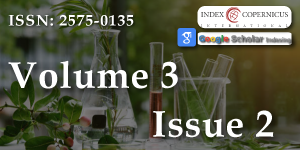Assessing the stand size of bay trees (Persea spp.) after exposure to laurel wilt disease in a North Florida Preserve
Main Article Content
Abstract
Although laurel wilt disease was first reported in the United States in 2002 from redbay trees (Persea borbonia) around Savannah, Georgia it has rapidly spread throughout the southeastern coastal plain including Georgia and Florida. In the current study, transects were used to assess the spread and impact of the disease on two native bay trees redbay (P. borbonia) and swampbay (P. palustris) from north Florida in a semi-naturalized ecological preserve. Although tree size and mortality rates have been reported previously, this study provides the first size-based static life tables for both species. While a significantly higher percent (76%) of swampbay trees exhibited signs of laurel wilt disease compared to redbay trees (62%); redbay had more of its canopy damaged by the disease (41% vs. 32% for redbay vs. swampbay respectively); this resulted in a significantly smaller stem diameter for P. borbonia compared to swampbay, both species are experiencing significant declines due to the disease. Both species exhibited a Type III survivorship curve in which the vast majority of individuals were in the smallest size class (average stem diameter was only 2.5 and 3.6 cm for redbay and swampbay respectively). Although traditionally, population age (or size) structure that is heavily biased toward younger or smaller size classes suggests that the population is likely to expand in the future, for these bay trees high mortality rate due to beetle/fungal infestation of larger size classes is responsible for this trend; the smallest size classes are largely free from beetle infestation and laurel wilt disease because the stem diameter is likely insufficient to support beetle development. Results from this study suggest that swampbay is also highly susceptible to laurel wilt disease and its populations are likely to exhibit a similar (albeit slower) decline in Florida’s wetland and mesic ecosystems.
Article Details
Copyright (c) 2019 Rossi AM, et al.

This work is licensed under a Creative Commons Attribution 4.0 International License.
Snyder JR. Ecological implications of laurel wilt infestation on Everglades tree islands in southern Florida. US Geological Survey Open-file Report. 2014; 1225: 18. Ref.: https://bit.ly/2Kn0tLs
Hughes MA, Smith JA, Ploetz RC, Kendra PE, Mayfield AE, et al Recovery plan for laurel wilt on redbay and other forest species caused by Raffaelea lauricola and disseminated by Xyleborus glabratus. Plant Health Progress. 2011; 16: 173-210. Ref.: https://bit.ly/2Klxk3d
Evert RF, Eichhorn SE. Raven Biology of Plants, 8th Edition. Freeman/Palgrave Mcmillan. Ann Bot. 2013; 113: 900. Ref.: http://bit.ly/2WTcpw4
Harrington TC, Yun HY, Lu SS, Goto H, Aghayeva DN, et al. Isolations from the redbay ambrosia beetle, Xyleborus glabratus, confirm that the laurel wilt pathogen, Raffaelea lauricola, originated in Asia. Mycologia. 2011; 103: 1028-1036. Ref.: https://bit.ly/2W9sNTG
Pisani C, Ploetz RC, Stover E, Ritenour MA, Scully B. Laurel wilt in avocado: Review of an emerging disease. Int J Plant Biol Res. 2015; 3: 1043. Ref.: https://bit.ly/2JWypPI
Hulcr J, Rountree NR, Diamond SE, Stelinski LL, Fierer N, et al. Mycangia of ambrosia beetles host communities of bacteria. Microb Ecol. 2012; 64: 784-793. Ref.: https://bit.ly/2wIwWEd
Koch FH, Smith WD. Spatio-temporal analysis of Xyleborus glabratus (Coleoptera: Curculionidae: Scolytinae) invasion in eastern U.S. forests. Environ Entomol. 2008; 37: 442-452. Ref.: https://bit.ly/2Z4n7ws
Mayfield III AE, Thomas MC. The redbay ambrosia beetle, Xyleborus glabratus Eichhoff (Scolytinae: Curculionidae). 2009; 4. Ref.: https://bit.ly/2Wb4Hbo
Evans EA, Crane J, Hodges A, Osborne JL. Potential economic impact of laurel wilt disease on the Florida avocado industry. HortTechnology. 2010; 20: 234-238. Ref.: https://bit.ly/2W5HlUA
Fraedrich SW, Harrington TC, Best GS. Xyleborus glabratus attacks and systemic colonization by Raffaelea lauricola associated with diback of Cinnamomum camphora in the southeastern United States. Forest Pathology. 2015; 45: 60-70. Ref.: https://bit.ly/2XvwZ1y
Hulcr J, Lou Q. The redbay ambrosia beetle (Coleoptera: Curculionidae) prefers Lauraceae in its native range: records from the Chinese national insect collection. Florida Entomologist. 2013; 96: 1595-1596. Ref.: https://bit.ly/2Xoztii
Mayfield III AE, Peña JE, Crane JH, Smith JA, Branch CL, et al. Ability of redbay ambrosia beetle (Coleoptera: Curculionidae: Scolytinae) to bore into young avocado (Lauraceae) plants and transmit the laurel wilt pathogen (Raffaelea sp.). Florida Entomologist. 2008; 91: 485-487. Ref.: https://bit.ly/2HQrNAa
Cameron RS, Hanula J, Fraedrich S, Bates C. Progression and impact of laurel wilt disease within redbay and sassafras populations in southeast Georgia. Southeastern Naturalist. 2015; 14: 650-674. Ref.: https://bit.ly/2WdrDXH
Kendra PE, Montgomery WS, Niogret J, Epsky ND. An uncertain future for American Lauraceae: a lethal threat from redbay ambrosia beetle and laurel wilt disease (A Review). Am J Plant Sci. 2013; 4: 727-738. Ref.: https://bit.ly/2QFJJAr
Fraedrich SW, Harrington TC, Rabaglia RJ, Mayfield AE 3rd, Hanula JL, et al. A fungal symbiont of the redbay ambrosia beetle causes a lethal wilt in redby and other Lauraceae in the southeastern United States. Plant Disease. 2008; 92: 215-224. Ref.: https://bit.ly/2wuZnoX
Hughes M, Smith JA, Mayfield AE 3rd, Minno MC, Shin K. First report of laurel wilt disease caused by Raffaelea lauricola on pondspice in Florida. Plant Disease. 2011; 95: 1588-1589. Ref.: https://bit.ly/2IcwUtm
Nelson G. The Shrubs and Woody Vines of Florida. Pineapple Press, Sarasota. 1996; 391. Ref.: https://bit.ly/2IiEEKB
Duncan WH, Duncan MB. Trees of the Southeastern United States. University of Georgia Press, Athens. 1998; 322. Ref.: https://bit.ly/2WkAI5D
Sibley DA. The Sibley Guide to Trees. Knopf, New York. 2009; 427. Ref.: https://amzn.to/2Klpg2x
Nelson G, Earle CJ, Spellenberg R. Trees of Eastern North America. Princeton University Press, Princeton. 2014; 720. Ref.: https://bit.ly/2WFmqvM
Leak WB. Relationship of tree age to diameter in old-growth northern hardwoods and spruce-fir. United States Department of Agriculture, Research Note NE. 1985; -329: 4. Ref.: https://bit.ly/2KnE0ho
Lukaszkiewicz J, Kosmala M. Determining the age of streetside trees with diameter at breast height-based mulifactoral model. Agriculture and Urban Forestry. 2008; 34: 137-143. Ref.: https://bit.ly/2WjW1o0
Parresol BR, Devall MS. Patterns of diametric growth in stem-analyzed laurel trees (Cordia alliodora) in a Panamanian forest. The Southwestern Naturalist. 2013; 58: 170-178. Ref.: https://bit.ly/313dNut

